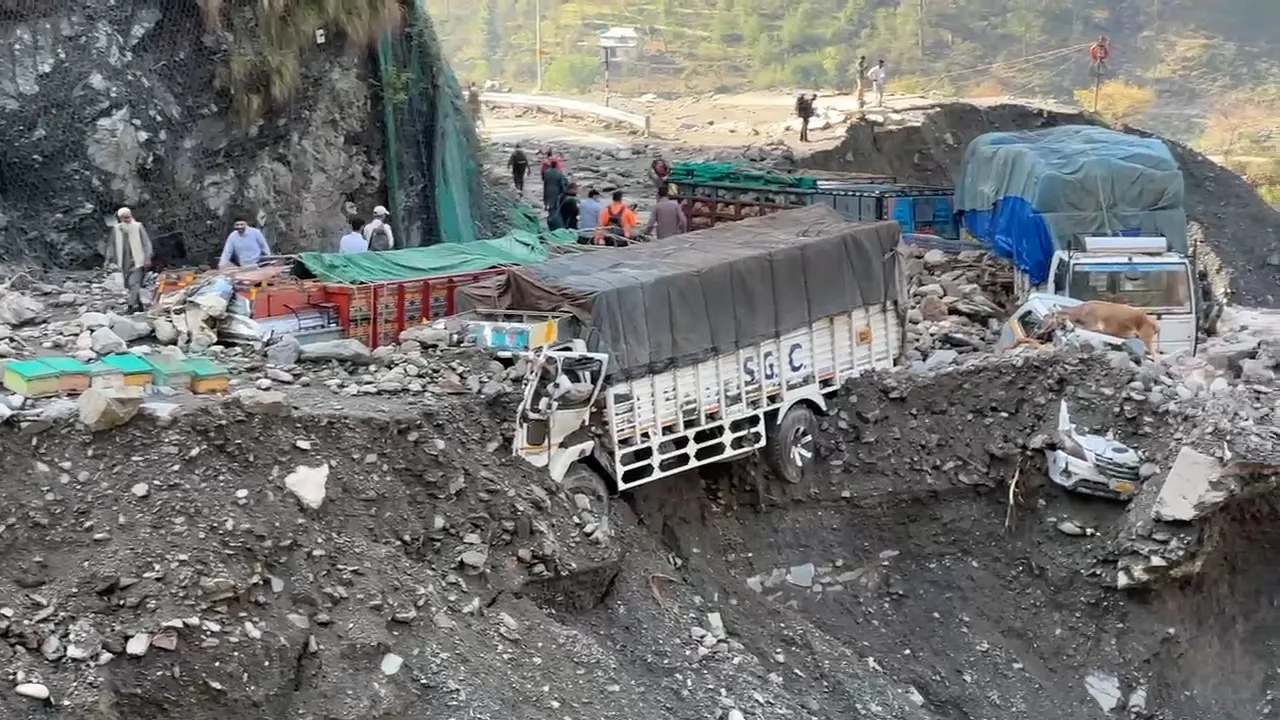Srinagar Jammu National Highway (NH-44), the only road connecting the Kashmir Valley with the rest of India, has long been seen as a strategic lifeline, essential for trade, transport, tourism, and security. However, despite ambitious plans and significant financial investments to transform it into an all-weather, four-lane expressway, the highway today stands as a symbol of engineering failures, environmental neglect, and policy oversight.Initially, like many regional roads, NH-44 served its purpose when traffic volumes were lower and demand on the infrastructure was modest.
Recognizing the growing pressure on the route and the strategic need for year-round connectivity, the Government of India undertook a major highway upgradation project in 2011. The road from Jammu to Srinagar was divided into several construction packages, with detailed project reports (DPRs) prepared by consultants outlining methodologies for expansion. From the Kashmir side, nearly 80 percent of the original alignment was changed, and after numerous delays, this section was completed in 2017.

Simultaneously, work began in the Jammu division. The Jammu to Udhampur section was completed in 2017, offering immediate relief to commuters. The construction of the Chenani-Nashri Tunnel, later named Dr.
Syama Prasad Mookerjee Tunnel, added further convenience by bypassing avalanche-prone and landslide-prone areas. Yet, as work moved deeper into the mountainous terrain of Ramban and Banihal, the project encountered its most formidable challenge.The Ramban–Banihal stretch became the most problematic and dangerous portion of the highway.
The initial DPR proposed expanding the highway by cutting vertical slopes along the existing route—an approach shockingly undertaken without comprehensive geotechnical investigations. The result was devastating. Large-scale hill cutting began, weakening the region’s fragile slopes and triggering a chain of landslides.
Years into the work, with little progress and increasing instability, it became evident that the plan was fundamentally flawed. The consultant responsible was blacklisted and fined, but the environmental damage was irreversible. The terrain, once stable, was left vulnerable to frequent slips and collapses.
To correct course, the government hired a new consultant who prepared a revised DPR based on detailed studies of the region’s geology. The updated plan recommended the construction of five tunnels to safely bypass the most dangerous sections of the road. This proposal was approved, tenders were issued, and construction resumed.
While this appeared to be a positive step, progress has continued to be marred by engineering failures and natural disasters.In 2023, the Cafeteria Morh tunnel project, aimed at bypassing a well-known slide zone, collapsed due to weak geological conditions. Cracks formed within the tunnel structure, halting work.
A canopy structure was proposed as an alternative, but this too faced complications. In March 2025, persistent rainfall caused the road in the area to sink, reducing movement to a single lane and exposing the inadequacies of both the original and revised designs. Experts argue that a better solution would have been to extend the Ramban viaduct instead of disturbing the already unstable area.
Now recently a similar story unfolded in the Seri region of Ramban, where slope protection measures such as rock bolting, geomats, and mesh netting were installed. Yet, during the recent rainfall, a massive landslide wiped out the work of the past three years. The failure raises alarming questions about whether the work was carried out as per design specifications or if the latest DPR had again underestimated the geological complexity.
The Kela Morh and Panthal areas, already notorious for frequent landslides, have seen multiple collapses despite the installation of tunnels and canopy structures. During the latest rainfall, even these protections failed, resulting in the destruction of infrastructure and, tragically, loss of life. In some places, such as Battery Chashma, the road has been completely washed away, and vehicles have plunged into deep gorges.
Thousands of vehicles remain stranded during such incidents, and the safety of travelers is repeatedly compromised.These recurring failures have sparked outrage and concern among locals and commuters alike. The broader question looms large: after spending thousands of crores on NH-44’s upgradation, why does the infrastructure fail within months or a year of completion? The causes could range from flawed engineering to poor project reports, or a lack of monitoring and accountability.
While punitive actions such as blacklisting consultants may help enforce standards, they do not compensate for the lives lost or the daily hardships faced by people using this critical route.The recent one-day spell of rain was enough to paralyze traffic and dismantle the claim of NH-44 being an all-weather highway. Ironically, it has also come to light that the Public Investment Board (PIB) rejected a proposal for two new tunnel projects on NH-244 (Chenani–Anantnag Section), reasoning that NH-44 already provides adequate year-round connectivity.
This decision, in the wake of current events, appears not only misinformed but dangerously shortsighted.There is an urgent need for the government to accept the ground reality and implement a stricter framework for road construction in ecologically sensitive zones. DPRs must be based on thorough scientific studies, and consultants must be held accountable for lapses.
Construction work must adhere rigorously to design specifications, and regular audits should be made mandatory. Above all, alternative routes must be developed to reduce dependency on a single corridor, especially in a region as vital and vulnerable as Jammu and Kashmir.NH-44 was envisioned as a symbol of modern connectivity and progress.
But unless serious steps are taken to address the recurring failures and systemic weaknesses, the highway risks becoming a grim reminder of what happens when ambition overtakes accountability, and when engineering ignores the environment. The need of the hour is not just road construction, but responsible, resilient, and sustainable infrastructure development—because the cost of negligence is being paid in lives. Peerzada Mohsin Shafi, from Anantnag, J&K, holds an M.
Tech in Infrastructure Development & Management. He is a research scholar, with several research papers on project management and construction. He is a member of ASCE, IAENG, and IIQS.
The post Engineering Flaws or Unforgiving Terrain? appeared first on Greater Kashmir..
Politics

Engineering Flaws or Unforgiving Terrain?

What’s Behind NH-44’s Collapse in the Ramban Section?The post Engineering Flaws or Unforgiving Terrain? appeared first on Greater Kashmir.















